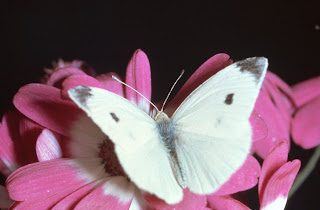"Cabbage Butterfly" and "Cabbage White" can also refer to the Large White. It is widespread across Europe, North Africa and Asia and has also been accidentally introduced to North America, Australia and New Zealand where they have become pests on cultivated cabbages and other mustard family crops.
The Large Cabbage White Butterfly is less widely distributed in the world than the Small. The caterpillars will be found on cruciferous crops, eg. cabbage, swede, kale, throughout the summer. The adult, nearly all-white butterfly emerges from the pupa (chrysalis) in April and May. The adult male has black markings on the tips of its wings; the female has the same marks with the addition of two black spots in the middle of each forewing. After mating the female lays 20 to 100 yellow eggs on the underside of cruciferous plant leaves.
 After about 14 days the larvae (caterpillars) of Cabbage White emerge then moult as they grow. They have well developed mandibles which they use with devastating effect on crops. This first generation pupates in June in a crevice or woody stem, emerging in July as the second generation which usually causes greater damage to crops in the garden, repeats the cycle and pupates to overwinter for the next year. Apart from brassica crops they will use wallflowers and other cruciferous plants (four-petalled flowers), as alternate hosts. If the damage is extensive and the leaves look torn, the culprits may be Pigeons. Slugs will also strip the leaves, but there will be a slime trail.
After about 14 days the larvae (caterpillars) of Cabbage White emerge then moult as they grow. They have well developed mandibles which they use with devastating effect on crops. This first generation pupates in June in a crevice or woody stem, emerging in July as the second generation which usually causes greater damage to crops in the garden, repeats the cycle and pupates to overwinter for the next year. Apart from brassica crops they will use wallflowers and other cruciferous plants (four-petalled flowers), as alternate hosts. If the damage is extensive and the leaves look torn, the culprits may be Pigeons. Slugs will also strip the leaves, but there will be a slime trail.

 10:48 AM
10:48 AM
 sadmovement
sadmovement



 Posted in:
Posted in: 







0 comments:
Post a Comment